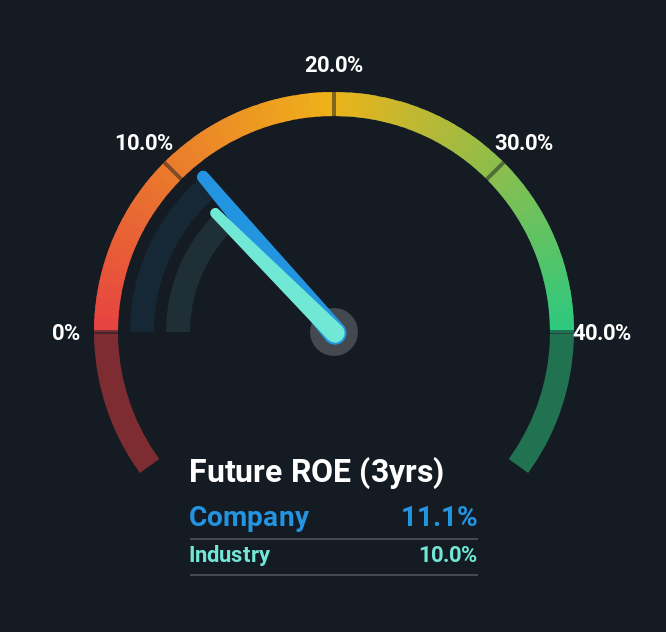While some investors are already well versed in financial metrics (hat tip), this article is for those who would like to learn about Return On Equity (ROE) and why it is important. By way of learning-by-doing, we’ll look at ROE to gain a better understanding of SLC Agrícola S.A. (BVMF:SLCE3).
Return on equity or ROE is a key measure used to assess how efficiently a company’s management is utilizing the company’s capital. Put another way, it reveals the company’s success at turning shareholder investments into profits.
How To Calculate Return On Equity?
The formula for return on equity is:
Return on Equity = Net Profit (from continuing operations) ÷ Shareholders’ Equity
So, based on the above formula, the ROE for SLC Agrícola is:
11% = R$582m ÷ R$5.3b (Based on the trailing twelve months to June 2025).
The ‘return’ is the amount earned after tax over the last twelve months. That means that for every R$1 worth of shareholders’ equity, the company generated R$0.11 in profit.
View our latest analysis for SLC Agrícola
Does SLC Agrícola Have A Good Return On Equity?
Arguably the easiest way to assess company’s ROE is to compare it with the average in its industry. The limitation of this approach is that some companies are quite different from others, even within the same industry classification. The image below shows that SLC Agrícola has an ROE that is roughly in line with the Food industry average (10%).
 BOVESPA:SLCE3 Return on Equity October 4th 2025
BOVESPA:SLCE3 Return on Equity October 4th 2025
So while the ROE is not exceptional, at least its acceptable. Even if the ROE is respectable when compared to the industry, its worth checking if the firm’s ROE is being aided by high debt levels. If so, this increases its exposure to financial risk. To know the 2 risks we have identified for SLC Agrícola visit our risks dashboard for free.
How Does Debt Impact Return On Equity?
Companies usually need to invest money to grow their profits. The cash for investment can come from prior year profits (retained earnings), issuing new shares, or borrowing. In the first two cases, the ROE will capture this use of capital to grow. In the latter case, the debt required for growth will boost returns, but will not impact the shareholders’ equity. In this manner the use of debt will boost ROE, even though the core economics of the business stay the same.
SLC Agrícola’s Debt And Its 11% ROE
It’s worth noting the high use of debt by SLC Agrícola, leading to its debt to equity ratio of 1.33. Its ROE is quite low, even with the use of significant debt; that’s not a good result, in our opinion. Debt does bring extra risk, so it’s only really worthwhile when a company generates some decent returns from it.
Summary
Return on equity is a useful indicator of the ability of a business to generate profits and return them to shareholders. Companies that can achieve high returns on equity without too much debt are generally of good quality. If two companies have around the same level of debt to equity, and one has a higher ROE, I’d generally prefer the one with higher ROE.
But when a business is high quality, the market often bids it up to a price that reflects this. It is important to consider other factors, such as future profit growth — and how much investment is required going forward. So you might want to take a peek at this data-rich interactive graph of forecasts for the company.
But note: SLC Agrícola may not be the best stock to buy. So take a peek at this free list of interesting companies with high ROE and low debt.
We’ve created the ultimate portfolio companion for stock investors, and it’s free.
• Connect an unlimited number of Portfolios and see your total in one currency
• Be alerted to new Warning Signs or Risks via email or mobile
• Track the Fair Value of your stocks
Have feedback on this article? Concerned about the content? Get in touch with us directly. Alternatively, email editorial-team (at) simplywallst.com.
This article by Simply Wall St is general in nature. We provide commentary based on historical data and analyst forecasts only using an unbiased methodology and our articles are not intended to be financial advice. It does not constitute a recommendation to buy or sell any stock, and does not take account of your objectives, or your financial situation. We aim to bring you long-term focused analysis driven by fundamental data. Note that our analysis may not factor in the latest price-sensitive company announcements or qualitative material. Simply Wall St has no position in any stocks mentioned.
